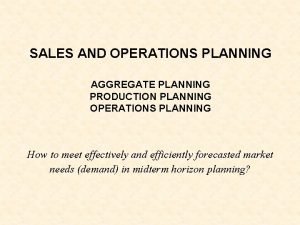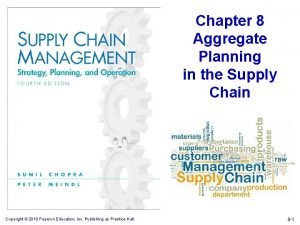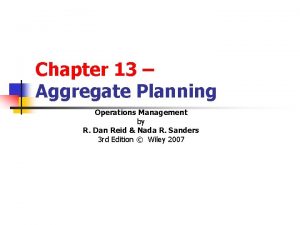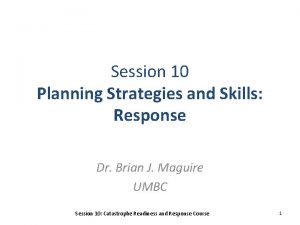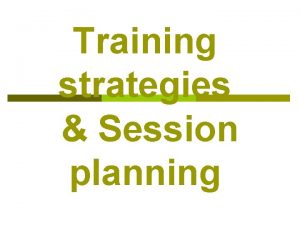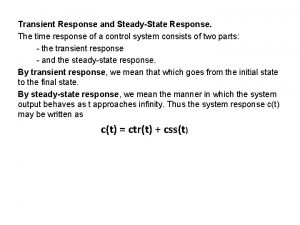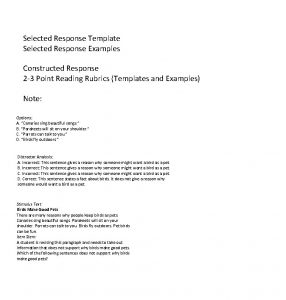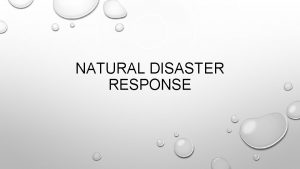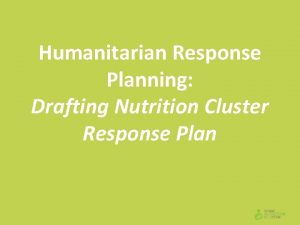Session 9 Planning Strategies and Skills Response Session






























- Slides: 30

Session 9 Planning Strategies and Skills: Response Session 9: Catastrophe Readiness and Response Course 1

“Plans are nothing; planning is everything. ” Dwight D. Eisenhower Session 9: Catastrophe Readiness and Response Course 2

Objectives By the end of this session (readings, lectures and exercises) the student should be able to: 1. Identify and discuss planning issues relating to the management of mass casualties. 2. Describe a risk management system for catastrophe response. 3. List and discuss three examples of the importance of flexibility in catastrophe response. Session 9: Catastrophe Readiness and Response Course 3

4. Discuss strategic thinking with regard to catastrophe response (e. g. where do we want to be and how do we get there under the circumstances of a catastrophe? ). 5. Describe and discuss objective based response management. 6. Explain the proper procedures for managing mass fatalities (e. g. display knowledge that mass graves / cremation are usually inappropriate and unnecessary). 7. Discuss planning needs for management of voluntary responders (NGOs, PVOs, and spontaneous volunteers Session 9: Catastrophe Readiness and Response Course 4

8. Describe methods of integrating international responders into the response effort. 9. Discuss systemic differences between disasters and catastrophes (in terms of response organization). 10. Discuss integration strategies. 11. List and discuss myths about catastrophes. Session 9: Catastrophe Readiness and Response Course 5

Suggested Readings • Posner, R. A. (2004). Catastrophe: Risk and Response. Oxford; New York: Oxford University Pres. • Redlener, I. (2006). Americans at Risk: Why We Are Not Prepared for Megadisasters and What We Can Do Now (1 st ed. ). New York: Knopf • Garb, J. L. , Cromley, R. G. , & Wait, R. B. (2007). Estimating Populations at Risk for Disaster Preparedness and Response [Electronic Version]. Journal of Homeland Security and Emergency Management, 4, Article 3. Retrieved March 2007 from http: //www. bepress. com/jhsem/vol 4/iss 1/3. • Clarke, L. B. (1999). Mission Improbable: Using Fantasy Documents to Tame Disaster. Chicago: University of Chicago Press. Session 9: Catastrophe Readiness and Response Course 6

Planning issues relating to the management of mass casualties. Who to include on planning committee • Disciplines – Emergency management – Public health – Health & medical • EMS • Hospitals – Public safety – Finance – Local elected officials Session 9: Catastrophe Readiness and Response Course 7

Planning Committee (con’t) • Jurisdictions - Neighboring cities and counties - States that may be impacted • Federal agencies – HHS – DHS – Military Session 9: Catastrophe Readiness and Response Course 8

Planning issues continued Evacuation issues • • • Who is in charge? Citizen response Patients Impact on surrounding jurisdictions Economic impact Health impact Session 9: Catastrophe Readiness and Response Course 9

Exercise • Break into small groups and discuss who should be on the mass casualty planning committee in the community. For the purpose of the exercise, select a community, or use an imaginary city. Decide the disciplines to include as well as the geographic and agency representatives. Session 9: Catastrophe Readiness and Response Course 10

Risk management system for catastrophe response • Allocation of scarce resources – Who decides how ventilators, personal protective equipment and other scarce resources will be allocated? Session 9: Catastrophe Readiness and Response Course 11

Risk assessment Types of risks – Natural catastrophes (e. g. pandemic, asteroids) – Scientific accidents (e. g. particle accelerator event, nanotechnology event)) – Other unintended man-made disasters (e. g. global warming) – Intentional catastrophes (e. g. nuclear attack) Session 9: Catastrophe Readiness and Response Course 12

Risk management – Managers “do not accept the idea that the risks they face are inherent in their situation. Rather, they believe that risks can be reduced by using skills to control the dangers. ” – “The experience of successful managers teaches them that the probabilities of life do not apply to them. ” – “The methods that had been employed successfully for the 243 previous major disaster declarations since January 2001 proved inadequate for Hurricane Katrina’s magnitude. ” Using risk management techniques that worked in previous emergencies, or even in previous disasters, may prove futile (or worse) in the environment of a catastrophe. Session 9: Catastrophe Readiness and Response Course 13

The importance of flexibility in catastrophe response • Many organizational cultures require strict adherence to established protocols • However, successful response to catastrophes require flexible leadership • If flexibility does not occur at the top, it may develop at the bottom and lead to inefficient procedures Session 9: Catastrophe Readiness and Response Course 14

Exercise • Ask the class to present examples of how incidents such as a pandemic or massive hurricane might require a flexible response. Ask them to be specific about how a current policy or procedure might be inadequate or inappropriate for such a large-scale event. Session 9: Catastrophe Readiness and Response Course 15

Strategic thinking • “Federal, State, and local officials responded to Hurricane Katrina without a comprehensive understanding of the interdependencies of the critical infrastructure sectors in each geographic area and the potential national impact of their decisions. For example, an energy company arranged to have generators shipped to facilities where they were needed to restore the flow of oil to the entire mid-Atlantic United States. However, FEMA regional representatives diverted these generators to hospitals. While lifesaving efforts are always the first priority, there was no overall awareness of the competing important needs of the two requests. ” Session 9: Catastrophe Readiness and Response Course 16

What are the long term goals – – – Survival Food and water Shelter Medical care Economic issues • What are the variables – How will citizens respond? – How will agencies respond? Session 9: Catastrophe Readiness and Response Course 17

Critical success factors related to strategic thinking Community Agency Government Pre-event Sufficient public education Community level drills Sufficient food and water for one week Mobilization and response plans are based on realistic scenarios Mobilization capacity and capability is adequate to meet expected needs Adequate resources are available for initial response in high threat areas Interorganizational coordination is preplanned Domain awareness and detection capability are created and maintained Mobilization and response plans are based on realistic scenarios Mobilization capacity and capability is adequate to meet expected needs Adequate resources are available for initial response in high threat areas Interorganizational coordination is preplanned; stakeholders are identified Event Local resources are rapidly and efficiently integrated into predetermined response organization Evacuations proceed in orderly fashion Mobilized response resources are rapidly and efficiently integrated into predetermined response organization Coordinated multiorganization, networked response system is established Ability to manage the collection, synthesis, analysis, and internal and external distribution of information is established Organizational and operational adaptability and agility is maintained Situational awareness is obtained and shared across distributed organizational network Resources in place are capable of initial life and safety response Resource mobilization is based on accurate estimate of need for people, funds, and equipment Resource mobilization is governed by preplanned organizational structure and process Post-event Repopulation occurs as resources and infrastructure become available Continuing needs are identified Organizational learning is accomplished Continuing needs are identified Plan for transition to local support of continuing needs is developed and followed External resources are demobilized according to established plans and procedures Resources are provided to support economic and social recovery Organizational learning is accomplished Session 9: Catastrophe Readiness and Response Course 18

Objective based response management • • Specific objectives for each member Participative decision making Explicit time period Performance evaluation and provide feedback Session 9: Catastrophe Readiness and Response Course 19

Managing mass fatalities Following the 2004 tsunami, Aceh Province, Indonesia reported that over 200, 000 people died. It took two months to bury the dead yet no epidemics were reported and even among those workers specifically dedicated to caring for remains, there was no increased rate of disease. Session 9: Catastrophe Readiness and Response Course 20

Key concepts: • mass graves / cremation are usually inappropriate and unnecessary • inappropriate management exacerbates stress and decreases recovery time for survivors • religious considerations for victims and community should be honored • photographic records and descriptions (e. g. gender, height, weight, etc. ) of bodies may help later identification Session 9: Catastrophe Readiness and Response Course 21

Planning needs for management of voluntary responders • “Volunteers have an important role to play in strengthening the capacity of local communities to resist the effects of disaster. Information exists to facilitate increased citizen involvement in disaster mitigation but has not been effectively communicated to help individuals and organizations identify and embrace appropriate volunteer opportunities. ” Session 9: Catastrophe Readiness and Response Course 22

Voluntary responders • Likely groups: NGOs, PVOs, and spontaneous volunteers • Food, water & shelter • Credentialing Session 9: Catastrophe Readiness and Response Course 23

Integrating international responders • “The Department of State, in coordination with the Department of Homeland Security, should review and revise policies, plans, and procedures for the management of foreign disaster assistance. In addition, this review should clarify responsibilities and procedures for handling inquiries regarding affected foreign nationals. ” Session 9: Catastrophe Readiness and Response Course 24

Issues • Language • Credentials • Resource compatibility (e. g. even meds may look different) • Supply chain challenges Session 9: Catastrophe Readiness and Response Course 25

Systemic differences between disasters and catastrophes • Resources will be spread over vastly larger areas • Federal and mutual aid resources may be unavailable for an extended time • The ability to provide food, water and shelter for victims (and responders) may be delayed for long periods of time • The incident may cause significant disruption of the area’s critical infrastructure • Medical personnel may be unavailable for long periods of time • Transportation and communication may be extremely limited Session 9: Catastrophe Readiness and Response Course 26

Exercise • Have small groups of students take on the roles of individual response agencies planning for catastrophes. • Examples of possible agencies include: a local emergency management agency, a state police agency or the Red Cross • Have them discuss how the agency will respond to catastrophes such as a pandemic, massive earthquake, or bioterrorism event. • Have each group report to the class on what key issues they decided when planning for each type of event from the perspective of the different agencies. Session 9: Catastrophe Readiness and Response Course 27

Integration strategies • Management officials must recognize that other agencies may have drastically different cultures – as well as different policies and procedures • Although integration of leaders is essential, it may be more efficient to have individuals from the same agency work together instead of splitting them up • Community level exercises are valuable opportunities to have personnel from disparate agencies learn more about the capabilities of other personnel and agencies • Exercises are also valuable opportunities to both check credentials and to emphasize the importance of proper credentialing Session 9: Catastrophe Readiness and Response Course 28

Myths about catastrophes • They’re just big disasters – When millions die, millions more are displaced (perhaps forever) and critical national infrastructures are broken for months or years, the rules become completely different from disaster response. • I’m in charge – Katrina proved that even a president cannot “manage” a catastrophe. The only hope is through collaborative efforts of wide ranging disciplines, agencies, communities and leaders. • We’re ready – We’ll never be ready. However, we can become more prepared today than we were yesterday. Session 9: Catastrophe Readiness and Response Course 29

Questions and Discussion Session 9: Catastrophe Readiness and Response Course 30
 Natural and forced response
Natural and forced response Natural response and forced response example
Natural response and forced response example Primary immune response and secondary immune response
Primary immune response and secondary immune response Toeic reading strategies
Toeic reading strategies Helping students practice skills, strategies, and processes
Helping students practice skills, strategies, and processes Aggregate planning strategies
Aggregate planning strategies 15 intrapersonal skills
15 intrapersonal skills Hard skills examples
Hard skills examples Simbang gabi prayer
Simbang gabi prayer Planning and organising skills in the workplace
Planning and organising skills in the workplace Planning techniques
Planning techniques Aggregate planning in supply chain management
Aggregate planning in supply chain management Aggregate planning strategies
Aggregate planning strategies Disaggregate planning
Disaggregate planning Strategy plan
Strategy plan Skills passport
Skills passport Inactivism planning
Inactivism planning Short term planning and long term planning
Short term planning and long term planning Language policy and planning ppt
Language policy and planning ppt Strategic planning vs tactical planning
Strategic planning vs tactical planning Planning balance sheet in urban planning
Planning balance sheet in urban planning Role segmentation workforce planning
Role segmentation workforce planning Aggregate planning is capacity planning for
Aggregate planning is capacity planning for Aggregate planning is capacity planning for
Aggregate planning is capacity planning for Aggregate planning is capacity planning for
Aggregate planning is capacity planning for What is translation loss
What is translation loss Product life cycle kotler
Product life cycle kotler Security strategies in windows platforms and applications
Security strategies in windows platforms and applications Security strategies in windows platforms and applications
Security strategies in windows platforms and applications Characteristics of skimming reading
Characteristics of skimming reading Chapter 17 promotional concepts and strategies
Chapter 17 promotional concepts and strategies










